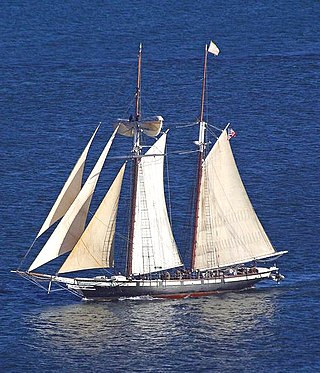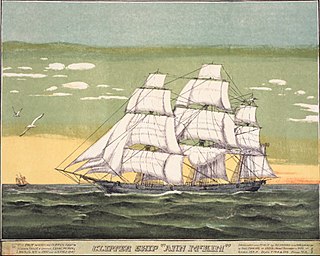
A clipper was a type of mid-19th-century merchant sailing vessel, designed for speed. Clippers were generally narrow for their length, small by later 19th-century standards, could carry limited bulk freight, and had a large total sail area. "Clipper" does not refer to a specific sailplan; clippers may be schooners, brigs, brigantines, etc., as well as full-rigged ships. Clippers were mostly constructed in British and American shipyards, although France, Brazil, the Netherlands, and other nations also produced some. Clippers sailed all over the world, primarily on the trade routes between the United Kingdom and China, in transatlantic trade, and on the New York-to-San Francisco route around Cape Horn during the California Gold Rush. Dutch clippers were built beginning in the 1850s for the tea trade and passenger service to Java.

A ship is a large vessel that travels the world's oceans and other navigable waterways, carrying cargo or passengers, or in support of specialized missions, such as defense, research and fishing. Ships are generally distinguished from boats, based on size, shape, load capacity and purpose. Ships have supported exploration, trade, warfare, migration, colonization, and science. Ship transport is responsible for the largest portion of world commerce.

A schooner is a type of sailing vessel defined by its rig: fore-and-aft rigged on all of two or more masts and, in the case of a two-masted schooner, the foremast generally being shorter than the mainmast. A common variant, the topsail schooner also has a square topsail on the foremast, to which may be added a topgallant. Differing definitions leave uncertain whether the addition of a fore course would make such a vessel a brigantine. Many schooners are gaff-rigged, but other examples include Bermuda rig and the staysail schooner.

A brig is a type of sailing vessel defined by its rig: two masts which are both square-rigged. Brigs originated in the second half of the 18th century and were a common type of smaller merchant vessel or warship from then until the latter part of the 19th century. In commercial use, they were gradually replaced by fore-and-aft rigged vessels such as schooners, as owners sought to reduce crew costs by having rigs that could be handled by fewer men. In Royal Navy use, brigs were retained for training use when the battle fleets consisted almost entirely of iron-hulled steamships.

Iron-hulled sailing ships represented the final evolution of sailing ships at the end of the age of sail. They were built to carry bulk cargo for long distances in the nineteenth and early twentieth centuries. They were the largest of merchant sailing ships, with three to five masts and square sails, as well as other sail plans. They carried lumber, guano, grain or ore between continents. Later examples had steel hulls. They are sometimes referred to as "windjammers" or "tall ships". Several survive, variously operating as school ships, museum ships, restaurant ships, and cruise ships.

The Pride of Baltimore was a reproduction of a typical early 19th-century "Baltimore clipper" topsail schooner, commissioned to represent Baltimore, Maryland. This was a style of vessel made famous by its success as a privateer commerce raider, a small warship in the War of 1812 (1812–1815) against British merchant shipping and the world-wide British Royal Navy. After the end of the war, Baltimore Clippers did not have sufficient cargo capacity for normal merchant trade, so some were used in the illegal opium trade into China and vessels of the same type were used in the transatlantic slave trade from Africa.

A Baltimore clipper is a fast sailing ship historically built on the mid-Atlantic seaboard of the United States, especially at the port of Baltimore, Maryland. An early form of clipper, the name is most commonly applied to two-masted schooners and brigantines. These vessels may also be referred to as Baltimore Flyers.

USS Duplin (AKA-87) was a Tolland-class attack cargo ship of the United States Navy, in service from 1945 to 1946. She was sold into merchant service in 1946 and finally scrapped in 1971.

SS Milwaukee Clipper, also known as SS Clipper, and formerly as SS Juniata, is a retired passenger ship and automobile ferry that sailed under two configurations and traveled on all of the Great Lakes except Lake Ontario. The vessel is now docked in Muskegon, Michigan.

Sea Witch was an American clipper ship designed by naval architect John W. Griffiths for the China trading firm of Howland & Aspinwall. She was launched at Smith & Dimon in Manhattan on December 8, 1846.

The S/V Denis Sullivan is a replica three-masted, wooden, gaff rigged schooner originally from Milwaukee, Wisconsin. She was a flagship of both the state of Wisconsin and of the United Nations Environment Programme until she was sold to the World Ocean School and moved to Boston, Massachusetts in late 2022.

Northern Light was an American clipper ship. In 1853 it sailed from San Francisco, California to Boston, Massachusetts via Cape Horn with Captain Freeman Hatch at the helm in a record-setting 76 days, 6 hours. The record still stands for a single hull vessel. In 1993 the record was soundly broken by a multi-hull sailing vessel Great American II with no cargo. Sailing around Cape Horn is widely regarded as one of the most challenging routes in yachting, due to extreme weather, strong currents, and a historical reputation for mountainous seas and frequent severe storms.

Corvus was a steam cargo ship built in 1919 by Columbia River Shipbuilding Company of Portland for the United States Shipping Board as part of the wartime shipbuilding program of the Emergency Fleet Corporation (EFC) to restore the nation's Merchant Marine. The freighter was operated on international and domestic routes through 1944. Early in 1945 she was transferred to Soviet Union as part of lend-lease program and renamed Uzbekistan. After several months of operation, the freighter was rammed by another vessel on 31 May 1945 and was beached to avoid sinking. She was subsequently raised and towed to Portland where she was scrapped in 1946.

The Liberty Clipper is a replica sailing ship whose design was inspired by the Baltimore Clipper style of vessels which were predominant along the East Coast in the early 19th century.

SV Golden Horizon is a steel-hulled five-masted barque rigged tall ship which is in service as a cruise ship. Originally named Flying Clipper, the luxury vessel was designed by Polish naval architect Zygmunt Choreń, for Star Clippers Ltd. of Sweden, and built by the Brodosplit Shipyard in Split, Croatia. She is the largest sailing ship ever launched. Her design was based on France II, a famous French five-mast cargo windjammer built in 1911.

Ann McKim was one of the early true clipper ships, designed to meet the increasing demand for faster cargo transportation between the United States and China in the early 1840s. The opening of new Treaty ports in the East allowed American merchants greater access to trade with China, leading to the need for ships that could move cargo more quickly than traditional merchant ships. Ann McKim was one of the ships that had answered the demand in the early years and sailed between New York and China in 1840–1842, until newer and faster cargo-carriers, such as the nearly 600-ton clipper Houqua, the 598-ton China packet Helena, Witch of theWave, and Rainbow started dominating the shipping world of the US-China trade and Ann McKim was shifted back to the South American trade routes.

Scottish Maid was a Scottish packet boat, a two-masted wooden schooner, built at Alexander Hall and Sons' boatyard in 1839 for the Aberdeen Line. She has been described as the first clipper vessel to be built in Britain. Her design of sharp, forward-raked bow, later called the "clipper bow" or Aberdeen bow, pioneered a succession of larger clipper ships with many also built in Aberdeen on Scotland's northeast coast.

The Harvey Gamage is a 131' gaff rigged schooner launched in 1973 from the Harvey F. Gamage Shipyard in South Bristol, Maine. She was designed by McCurdy & Rhodes, Naval Architects in Cold Spring Harbor, New York and Frederick W. Bates of Damariscotta, Maine. She is a USCG inspected vessel both as a passenger vessel and a sail training vessel. As governments of maritime countries recognise Sail Training as an essential component of developing and maintaining an essential merchant marine force, the US Congress created a special service category of vessel for Sail Training and the Harvey Gamage is one of a handful of vessels licensed for this service. She has been educating students at sea along the east coast of North American almost continuously since her launch. She has 14 staterooms accommodating 39 people, including 9 professional crew, 22 youth sail trainees and up to 4 adult chaperones. As a training vessel, she takes crews of students along the eastern seaboard, from her home port in Maine to various destinations ranging from The Maritimes to the Caribbean


















